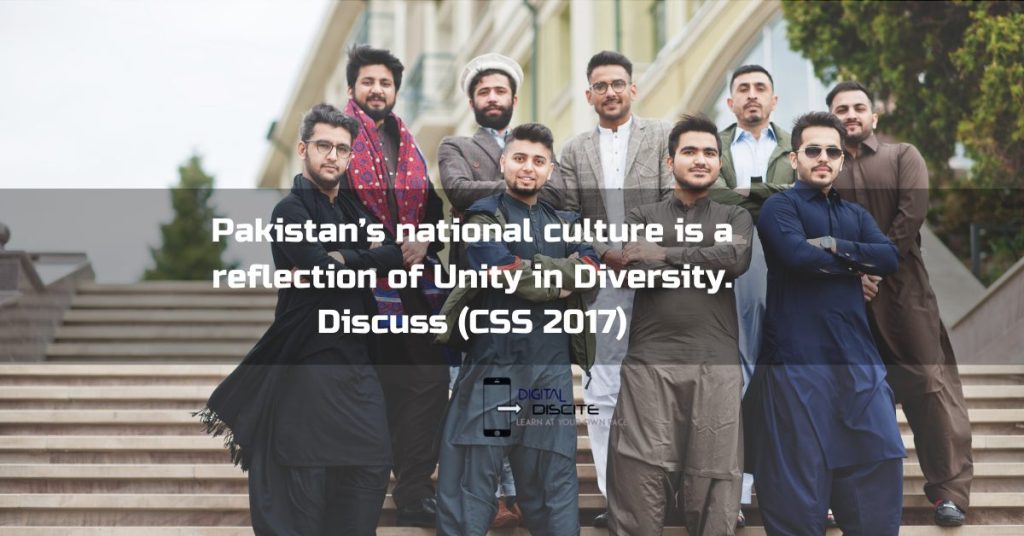I. Introduction: Pakistan's National Culture Reflects Unity in Diversity
“Our diverse culture reflects unity in diversity.”
(Maleeha Lodhi, Pakistan beyond the crisis state)
Pakistan is a multi-cultural society where different ethnic communities live. The culture does not vary from province to province but also from city to city. Through the language, costumes, leaders, events, religious beliefs, music, cultural practices, and cuisines that vary throughout the country, there are threads that unite Pakistan on many levels. This is the reason that despite a diverse culture, Pakistan’s national culture is all-inclusive and embracing. Indeed, Pakistan’s national culture reflects unity in diversity.
II. Defining Culture
Edward B. Taylor defines culture as:
“That whole which includes knowledge, belief, art, morals, law, custom, and any other capabilities and habits acquired by man as a member of society.“
Generally, Culture means the ideas, customs, and social behavior of a particular people or society. It is reflected through cuisines, dresses, literature, music, arts, sports, festivals, traditions, and entertainment.
III. Defining Pakistan’s National Culture
The National Culture of Pakistan can be defined as an amalgam of material and non-material practices among the diverse ethnic groups residing in the country, shaping its unique outlook.
In simple words, Pakistan’s national culture is a haven of many cultures and ethnicities, where each group contributes its distinct practices and traditions.
This rich tapestry of diversity exemplifies how Pakistan’s national culture reflects unity in diversity, showcasing a harmonious blend of traditions that coexist and enrich one another.
IV. How Pakistan’s National Culture is Diverse
Following are the aspects due to which Pakistan’s National Culture is diverse:
1. Language
Pakistan is the hub of many languages, with over 300 dialects and languages spoken. After every few kilometers, you get to hear a new dialect.
According to the Pakistan Bureau of Statistics, the population in percentages by mother tongue in Pakistan is 7.57% Urdu, 44.15% Punjabi, 14.15% Sindhi, 15.42% Pashto, 3.57% Balochi, 10.53% Saraiki, and 4.66% others.
This linguistic diversity is a testament to the richness of the country’s cultural heritage and reinforces the idea that Pakistan’s national culture reflects unity in diversity.

2. Ethnic Groups
There are approximately 15-20 ethnic groups in Pakistan, including Punjabis, Sindhis, Pashtuns, Balochi, Siraikis, Chitralis, Hindkowans, Gujratis, Kashmiris, Sulangi, Kalay, Brushus, Hazaras, Baltis, Baloch, and Makranis.
These groups, with their unique histories, customs, dresses, physical features, food, and music, showcase the rich tapestry of cultural diversity in the country. Together, they form a vibrant mosaic that highlights how Pakistan’s national culture reflects unity in diversity.
3. Festivals
There are different festivals celebrated by different cultural groups in Pakistan. In Punjab, the arrival of spring and the harvest of crops is the main time when people dance and take part in different festivals.
In Sindh, Sindhi Cultural Day is celebrated every year on the first Sunday of December.
4. Music
In Punjab, classic music forms a major part of the Punjabi culture. Instruments like tabla, sitar, bansuri, harmonium, and dhol are common instruments. In Sindh, Ektaro, Tanpuro, and Been are common musical instruments that show diversity.
5. National Dress
Punjabis normally wear clothes like pagri, dhoti, kurta, khusa, gharar, lacha, parranda and choli.
On the other hand, Sindhis normally wear Shalwar Kamiz, with ajrak and topi whereas female of Sindh especially rural areas of Sindh prefer to wear gaj dresses.
In KPK, people wear kufi, Kandhari topi, Turban or Pakul. In Balochistan, men wear wide loose shalwar and knee-long shirts whereas women wera dresses consists of big pocket in front and chaddar to cover their heads.
V. How Pakistan's National Culture Reflects Unity in Diversity
Pakistan’s National Culture Reflects Unity in Diversity because:
1. Religion
The biggest reason behind Pakistan’s national culture reflects unity in diversity is religion. Pakistan was made under the slogan of “Pakistan ka matlab kia La Ilaha Illallah.”
Whether it is Balochi, Sindhi, Punjabi, or Pathan, all worked together to make their dream true. All believe in one Allah and the 98% of Pakistani people are Muslim, which is why the faith and belief in one God, despite the different cultures.
2. National Defense
Despite their different cultures, everyone loves Pakistan and works for national defense. There is no discrimination in terms of serving their motherland. No matter if a person is Sindhi, Punjabi, Balochi, or Pathan, they defend the national borders with the same spirit.
3. Hospitality
Pakistani people are very hospitable and welcoming. The culture of a joint family system, valuing the guests, and respecting the elders are the most beautiful aspects of Pakistani society.
Though the way of treating guests is different, everyone respects the guests and treats them with the best they can. Thus, this shows Pakistan’s national culture reflects unity in diversity.
4. Sports
Though there are different regional sports in all provinces, they all play the national games under one shadow. Like in cricket and football, people from all ethnicities join together to play for the nation.
5. Festivals Are Held in Social Harmony
Pakistan is a virtual heaven for many cultures and ethnicities. From Eids to Christmas, Ashura to Eid Milad-un-Nabi, Ramazan to Easter, Basant to Holi, all religious events and festivals are held in an atmosphere of social harmony. Like in Punjab, Punjabi and Sindhi sit together; in Sindh, Balochi and Punjabi share the same desk.
VI. Analysis
Pakistan is home to almost 252 million people with diverse social, ethnic, linguistic, and cultural circumstances. But, it has one national language, one national flag, and one common dress.
The diverse culture of Pakistan is its beauty. Pakistan is a country with extensive diversity from Punjabis to Balochis, Muslims to Hindus, Sunni to Shia, and Pashtuns to Hazaras.
This multi-lingual, multi-ethnic, and multi-cultural society depicts Pakistan’s rich pluralistic image. Despite the heterogeneous environment and coexistence of different cultures, one loves to call him Pakistani. Thus, Pakistan’s national culture reflects unity in diversity in general.
VII. Conclusion
Culture is the ideas, customs, and social behavior of a particular society. Pakistan’s national culture reflects unity in diversity. Every culture is different, and that is the beauty of Pakistan. Pakistan has a culture united and cemented in the diversity of socio-political thoughts and cultural variations. Moreover, in the words of Mikhail Gorbachev, “Peace is not unity in similarity, but unity in diversity, in the comparison and conciliation of differences.” Thus, Pakistan’s national culture brings social harmony and unity in diversity.
Book Summary: Pakistan Beyond the Crisis State by Maleeha Lodhi

